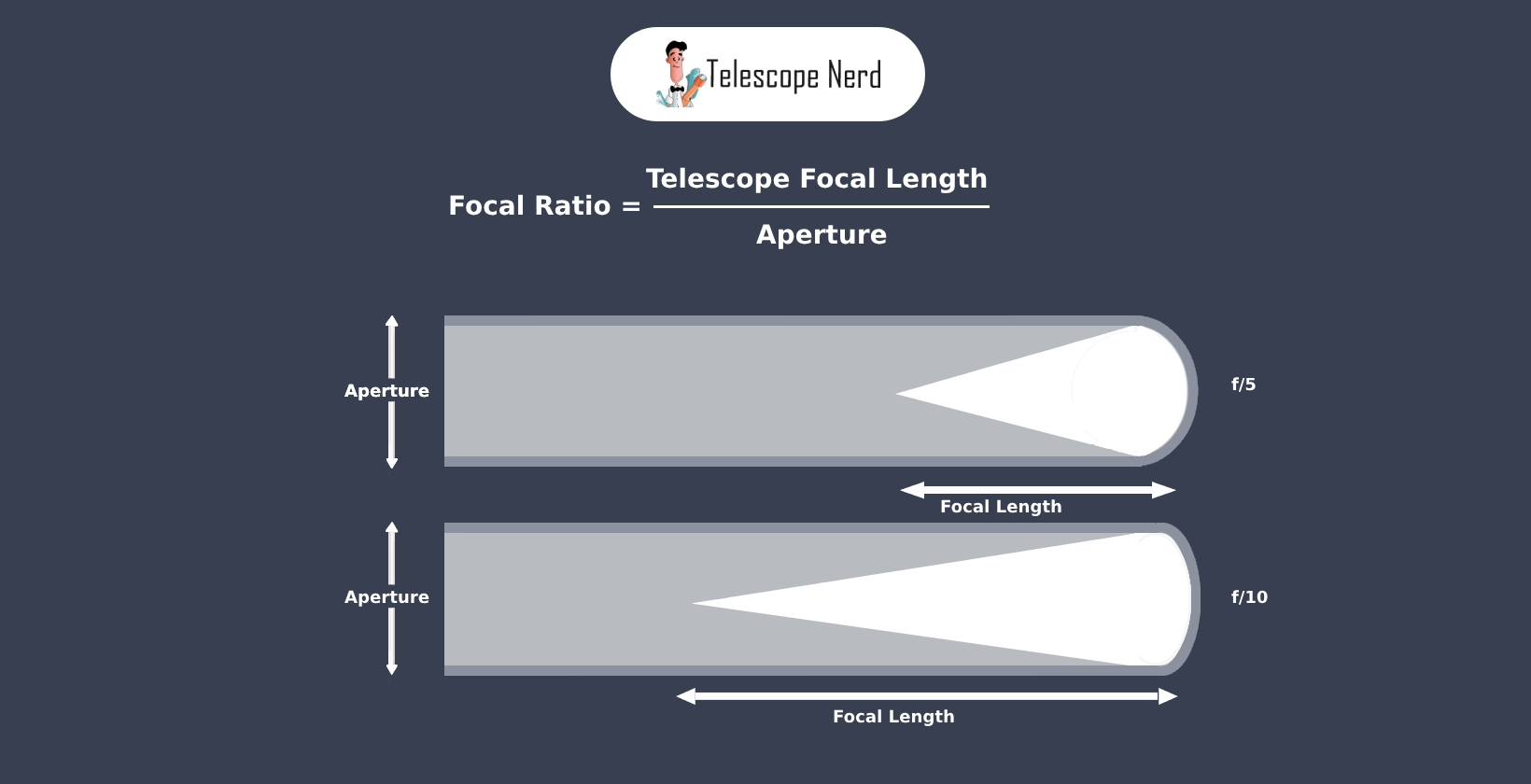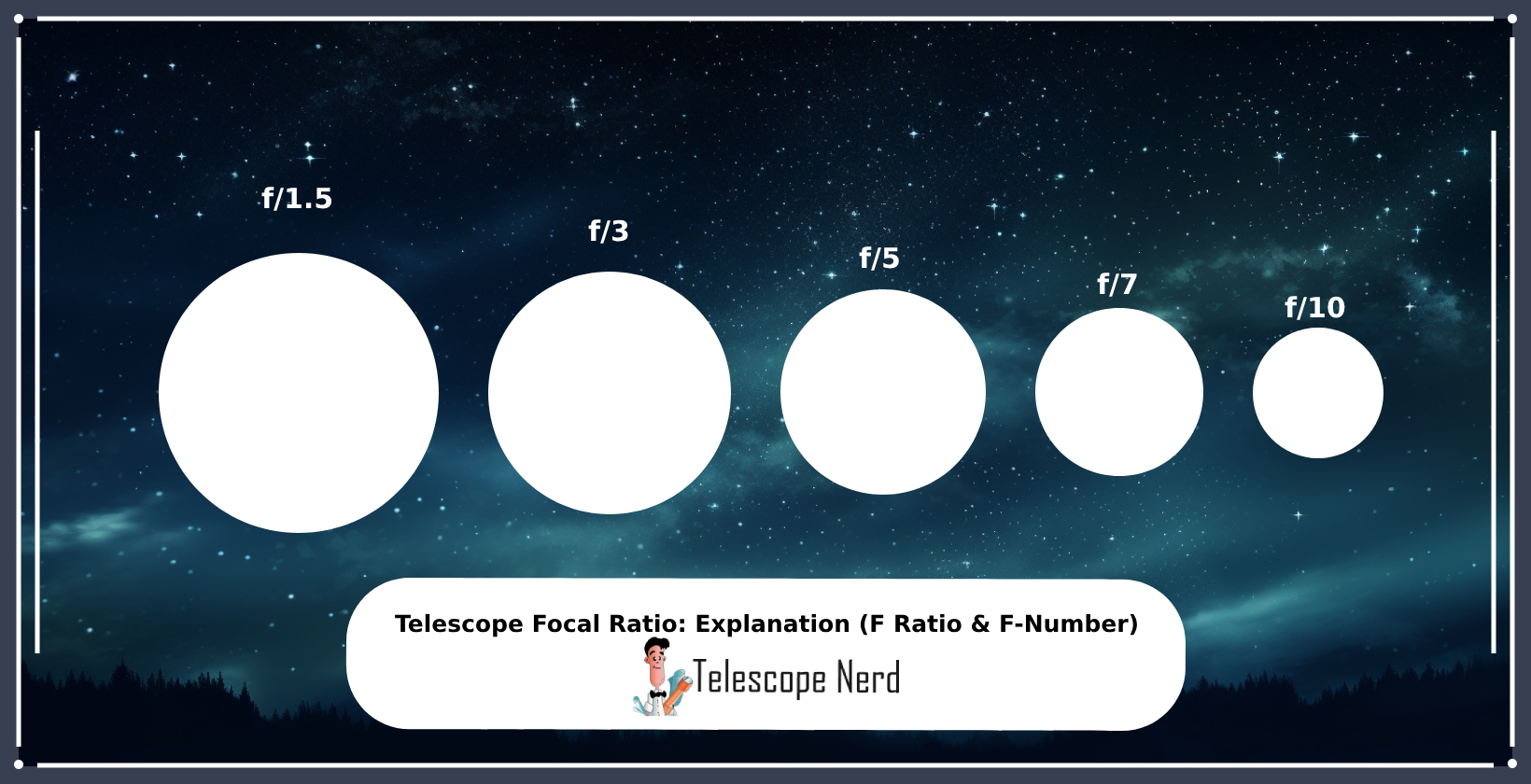Telescope Focal Ratio: Explanation (F Ratio & F-Number)
Focal ratio, also known as the “f-number,” “f-ratio,” or “aperture ratio,” defines the relationship between the focal length of a telescope and the diameter of its primary optic. The focal ratio is calculated by dividing the telescope’s focal length by the diameter of the aperture.
Knowing the focal ratio is crucial as it serves as an indicator of the telescope’s ‘speed’. A telescope’s ‘speed’ refers to its ability to collect and focus light. A lower telescope f-ratio, such as f/5, is considered ‘fast’. These ‘fast’ telescopes, due to their wider apertures, allow more light to enter. This makes ‘fast’ f-ratios better for wide-field, low-magnification viewing, and astrophotography. They allow more light to enter, which is beneficial when observing faint objects like nebulae and galaxies.
A higher telescope f number, such as f/10, is considered ‘slow’. These ‘slow’ telescopes have smaller apertures and longer focal lengths, making them better suited for high-magnification viewing of planets and other small, bright objects. Knowing the focal ratio is essential for anyone interested in astronomy or astrophotography. This value is a key factor that affects the performance and functionality of a telescope. The focal ratio influences the brightness of the image, the field of view, and the magnification.
How to Calculate the Focal Ratio of a Telescope?
To calculate the focal ratio of a telescope, divide the focal length of the telescope by its aperture. The focal length is the distance from the telescope’s primary lens or mirror to the point where the light comes into focus. The aperture, on the other hand, is the diameter of the telescope’s primary lens or mirror. This formula allows observers to easily determine their f ratio.
Focal Ratio = Focal Length (mm) / Aperture Diameter (mm)
This formula allows us to determine the f-ratio, commonly denoted as f/number, which provides essential information about a telescope’s speed, field of view, and potential magnification. For instance, if a telescope has a focal length of 1000mm and an aperture of 200mm, the focal ratio would equal 5. This ratio would be written as f/5.
To calculate the focal ratio, observers must know the focal length and aperture. The focal length and aperture of a telescope are usually provided on the packaging or the optics themselves. However, if the aperture is not provided, it can be measured as the diameter of the telescope’s primary lens or mirror. 
How Does Telescope Focal Length Affect Focal Ratio?
Focal length directly affects focal ratio, if focal length is changed it will equally change the focal ratio. Telescope focal length is the distance from the primary lens or mirror to the point where the light rays come together in focus. Knowing the focal length allows observers to calculate the focal ratio and understand the magnification, field of view and brightness of an image.
For example, a telescope with a long focal length and a small aperture will have a high f-ratio. This means the telescope will have a narrow field of view and high magnification, making it ideal for observing small objects like planets. Conversely, a telescope with a short focal length and a large aperture will have a low f-ratio. This means the telescope will have a wide field of view and low magnification, making it ideal for observing large objects like nebulae and galaxies.
The relationship between the focal ratio and the focal length is important because it affects the magnification, field of view and brightness of the image produced by the telescope. By understanding how focal ratio and focal length interact, users are able to choose a telescope that best suits their observational goals.
How Does Telescope Focal Ratio Affect Magnification?
Focal ratio directly affects magnification, if focal ratio is changed it simultaneously changes the magnification. Telescope magnification is the measure of how much larger an object appears through the telescope compared to the naked eye.
A lower f-ratio, such as f/5, results in a wider field of view and lower magnification. This means that the telescope will display a larger portion of the night sky, making it ideal for observing expansive celestial objects like nebulae or wide regions of the cosmos. Telescopes with lower f-ratios are particularly well-suited for deep-sky viewing, offering impressive vistas of extended structures and star clusters. Conversely, a telescope with a higher f-ratio, like f/10, will result in a narrower field of view and higher magnification. This specification would allow for a more detailed view of smaller, distant celestial bodies, such as planets or distant galaxies. Telescopes with higher f-ratios are especially useful for planetary observation, as they enable the capture of finer surface features and subtle details on these distant objects.
The focal ratio’s impact on telescope magnification is crucial because it directly influences how a telescope works in different astronomical observations. This is because focal ratio directly influences their magnification, image quality, and light-gathering ability during observations. Because of this, astronomers must select an appropriate focal ratio based on their observation goals.
Why is the Focal Ratio Important for Telescope to Work?
The focal ratio is important for a telescope to work because it influences the field of view, the brightness of the image, and the magnification. A telescope with a high f-ratio will have a narrow field of view and high magnification, making it ideal for observing small objects like planets. On the other hand, a telescope with a low f-ratio will have a wide field of view and low magnification, making it ideal for observing large objects like nebulae and galaxies.
Understanding the focal ratio and how a telescope functions is essential for both viewing and astrophotography. This ratio influences the field of view, magnification, and exposure times for astrophotography. Therefore, when choosing a telescope, it’s important to consider the f-ratio and how it aligns with the intended use of the telescope.

